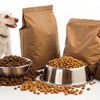How to Make Dog Kibble Better: Elevate Your Dog's Diet with Simple Additions
- Houndsy
Table of Contents
- Introduction
- Understanding Kibble: The Good, the Bad, and the Solutions
- Nutritional Additions: What to Include in Your Dog’s Kibble
- Creating a Balanced Meal: Proportions and Guidelines
- The Houndsy Kibble Dispenser: Elevating Mealtime Experience
- Conclusion
Introduction
Did you know that over 60% of dog owners in the U.S. primarily feed their pets kibble? While this convenient option is popular for its affordability, many pet parents are unaware of the limitations that come with a dry food diet. Kibble, despite its practicality, often falls short in delivering the nutritional variety that our furry companions need for optimal health. This realization can leave dog owners wondering: how can we enhance our dog's meals without completely overhauling their diet?
In this blog post, we will explore how to make dog kibble better. We aim to provide you with practical and easy strategies to elevate your dog's daily feeding experience. From incorporating fresh ingredients to understanding the importance of nutrition, we’ll cover various ways to enhance the nutritional profile of your dog’s kibble. By the end of this article, you will have a toolkit of ideas that can transform mealtime from mundane to magnificent.
As we delve into this topic, we invite you to reflect on your own pet feeding routines. Are you simply pouring kibble into a bowl, or are you actively engaging in your dog's nutritional needs? Our mission at Houndsy is to simplify and elevate the dog-feeding experience, and we believe that enhancing kibble is a significant step in this journey.
Let’s embark on this exploration of making dog kibble better together!
Understanding Kibble: The Good, the Bad, and the Solutions
The Basics of Kibble
Kibble is a staple in many households due to its convenience; however, the reality is that it is a highly processed food. During the manufacturing process, high temperatures can strip away many natural nutrients, leading to a product that often requires synthetic additives to compensate. While kibble can provide a balanced diet, it lacks the freshness and variety that your dog may crave.
The Nutritional Gaps in Kibble
Many commercial kibbles contain high levels of carbohydrates, which dogs do not require in large quantities. As a result, some dogs may experience weight gain or digestive issues. Additionally, some kibbles are loaded with fillers and low-quality ingredients that can negatively impact your dog’s health. Awareness of these gaps allows us to take proactive measures in our dog's diet.
Solutions to Enhance Kibble
Fortunately, there are numerous ways to make kibble better and more nutritious. By adding fresh foods, supplements, and other enhancements, we can create a more balanced and enjoyable meal for our furry friends. Now, let's explore the specific additions that can make a significant difference.
Nutritional Additions: What to Include in Your Dog’s Kibble
1. Fresh Fruits and Vegetables
Why They Matter: Fruits and vegetables are rich in vitamins, minerals, and antioxidants that are essential for your dog's overall health.
Recommended Additions:
- Carrots: High in beta-carotene, which promotes good vision.
- Blueberries: Packed with antioxidants that support cognitive function.
- Pumpkin: A digestive hero that aids in gut health.
- Sweet Potatoes: A great source of fiber and vitamins.
How to Prepare: Lightly steam or puree vegetables to improve digestibility, as dogs often cannot break down raw plant cell walls effectively.
2. Protein Boosters
Why They Matter: Protein is crucial for muscle development, energy, and overall health.
Recommended Additions:
- Cooked Chicken or Turkey: Lean meats that are easily digestible.
- Eggs: A complete protein source that provides essential amino acids.
- Canned Fish: Options like sardines or salmon are rich in omega-3 fatty acids, which are great for skin and coat health.
How to Prepare: Always ensure meat is cooked without seasoning or bones. You can mix cooked protein into kibble or serve it as a topping.
3. Dairy Products
Why They Matter: Many dogs can benefit from the protein and calcium found in dairy products.
Recommended Additions:
- Plain Yogurt: A good source of probiotics that help with digestion.
- Cottage Cheese: A protein-rich option that many dogs love.
How to Prepare: Introduce dairy in moderation, starting with small amounts to observe your dog's tolerance.
4. Healthy Fats
Why They Matter: Fats are essential for energy and help maintain healthy skin and coat.
Recommended Additions:
- Fish Oil: Provides omega-3 fatty acids that support joint and heart health.
- Olive Oil: A great source of healthy fats that can enhance the palatability of kibble.
How to Prepare: Drizzle a small amount over the kibble before serving.
5. Whole Food Supplements
Why They Matter: These provide additional nutrients that may be lacking in commercial dog food.
Recommended Additions:
- Spirulina and Chlorella: Algae packed with vitamins and minerals.
- Mushroom Powder: Certain mushrooms can support immune health.
How to Prepare: Mix powdered supplements into the kibble or sprinkle them on top.
6. Digestive Aids
Why They Matter: A healthy gut is crucial for nutrient absorption and overall well-being.
Recommended Additions:
- Probiotic Supplements: Promote a healthy gut flora.
- Prebiotic Foods: Foods like dandelion greens or garlic can help feed good bacteria.
How to Prepare: Choose high-quality supplements or fresh prebiotic foods to mix with kibble.
Creating a Balanced Meal: Proportions and Guidelines
What to Avoid
While enhancing kibble can be beneficial, it's essential to avoid overdoing it. Too many additives can lead to an unbalanced diet. Here are some things to keep in mind:
- Limit treats and additions to no more than 25% of your dog’s daily caloric intake.
- Be cautious with ingredients that may be toxic to dogs, such as onions, grapes, and chocolate.
Incorporating Enhancements
When introducing new foods to your dog's diet, it’s best to do so gradually. Start with small amounts and observe your dog’s response. This approach can help prevent digestive upset and ensure that your dog enjoys their enhanced meals.
The Houndsy Kibble Dispenser: Elevating Mealtime Experience
As we work to make dog kibble better, it's essential to consider the feeding experience itself. The Houndsy Kibble Dispenser is designed to simplify and enhance the daily feeding ritual. With its mid-century modern design and ergonomic convenience, we can elevate mealtime into a more enjoyable experience for both pet and owner.
Key Features
- Convenient Crank: Located at a standing height to eliminate bending, making it easier to serve your dog.
- Perfect Portion Control: Ensures your dog receives the right amount of food every time.
- Large Storage Capacity: Holds 25-30 lbs of kibble, reducing the frequency of refills.
- BPA-Free Liner: Keeps food fresh and safe for your dog.
By integrating the Houndsy Kibble Dispenser into your daily routine, you can ensure that every meal is served with care and style. Explore our product page to learn more about how this innovative solution can transform your dog’s feeding experience: Houndsy Kibble Dispenser.
Conclusion
As dog owners, we have the power to make our pets' diets healthier and more enjoyable. By understanding the limitations of kibble and actively seeking to enhance it with fresh foods and supplements, we can significantly improve our dogs' nutrition and overall well-being. We hope this guide on how to make dog kibble better inspires you to take actionable steps in your pet care routine.
Let’s work together to elevate the feeding experience for our furry companions! Whether you choose to add fresh fruits, protein boosters, or even invest in the Houndsy Kibble Dispenser, every small change counts. After all, a happier and healthier dog leads to a happier home.
FAQ
1. Can I add any fruit to my dog's kibble? Not all fruits are safe for dogs. Always avoid grapes, raisins, and any seeds or pits. Safe options include apples, blueberries, and bananas.
2. How much of each addition should I use? Start small and gradually increase the amount. A good rule of thumb is to limit additions to no more than 25% of your dog's daily caloric intake.
3. Is it safe to feed my dog raw eggs? Raw eggs can be safe in moderation, but cooking them can enhance digestibility. Always consult your veterinarian if you have concerns.
4. Should I soak kibble before feeding? Soaking kibble can make it easier to chew and digest, especially for older dogs or those with dental issues.
5. What if my dog refuses to eat the enhanced kibble? If your dog is hesitant, try different combinations of additions until you find what they enjoy. You may also want to consider rotating flavors and textures to keep their meals exciting.
By following these guidelines and maintaining an open line of communication with your veterinarian, you can confidently enhance your dog's kibble, ensuring they receive the nutrition they deserve while enjoying every meal.












